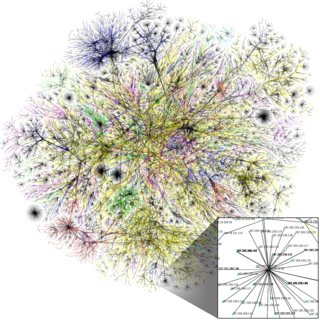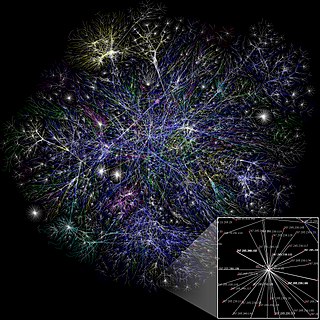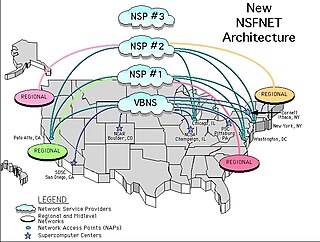
The history of the Internet has its origin in the efforts of scientists and engineers to build and interconnect computer networks. The Internet Protocol Suite, the set of rules used to communicate between networks and devices on the Internet, arose from research and development in the United States and involved international collaboration, particularly with researchers in the United Kingdom and France.

Janet is a high-speed network for the UK research and education community provided by Jisc, a not-for-profit company set up to provide computing support for education. It serves 18 million users and is the busiest National Research and Education Network in Europe by volume of data carried. Previously, Janet was a private, UK-government funded organisation, which provided the JANET computer network and related collaborative services to UK research and education.

The Internet backbone is the principal data routes between large, strategically interconnected computer networks and core routers of the Internet. These data routes are hosted by commercial, government, academic and other high-capacity network centers as well as the Internet exchange points and network access points, which exchange Internet traffic internationally. Internet service providers (ISPs) participate in Internet backbone traffic through privately negotiated interconnection agreements, primarily governed by the principle of settlement-free peering.

A Tier 1 network is an Internet Protocol (IP) network that can reach every other network on the Internet solely via settlement-free interconnection. Tier 1 networks can exchange traffic with other Tier 1 networks without paying any fees for the exchange of traffic in either direction. In contrast, some Tier 2 networks and all Tier 3 networks must pay to transmit traffic on other networks.
The National Science Foundation Network (NSFNET) was a program of coordinated, evolving projects sponsored by the National Science Foundation (NSF) from 1985 to 1995 to promote advanced research and education networking in the United States. The program created several nationwide backbone computer networks in support of these initiatives. It was created to link researchers to the NSF-funded supercomputing centers. Later, with additional public funding and also with private industry partnerships, the network developed into a major part of the Internet backbone.
Internet exchange points are common grounds of IP networking, allowing participant Internet service providers (ISPs) to exchange data destined for their respective networks. IXPs are generally located at places with preexisting connections to multiple distinct networks, i.e., datacenters, and operate physical infrastructure (switches) to connect their participants. Organizationally, most IXPs are each independent not-for-profit associations of their constituent participating networks. The primary alternative to IXPs is private peering, where ISPs directly connect their networks.
SURAnet was a pioneer in scientific computer networks and one of the regional backbone computer networks that made up the National Science Foundation Network (NSFNET). Many later Internet communications standards and protocols were developed by SURAnet.
The MAE was the first Internet Exchange Point (IXP). It began in 1992 with four locations in Washington, D.C., quickly extended to Vienna, Reston, and Ashburn, Virginia; and then subsequently to New York and Miami. Its name stood for "Metropolitan Area Ethernet," and was subsequently backronymed to "Metropolitan Area Exchange, East" upon the establishment of MAE-West in 1994. The MAE predated the National Information Infrastructure plan, which called for the establishment of IXPs throughout the United States. Although it initially had no single central nexus, one eventually formed in the underground parking garage of an office building in Vienna, VA.

Internet governance consists of a system of laws, rules, policies and practices that dictate how its board members manage and oversee the affairs of any internet related-regulatory body. This article describes how the Internet was and is currently governed, some inherent controversies, and ongoing debates regarding how and why the Internet should or should not be governed in the future.

The INOC-DBA hotline phone system is a global voice telephony network that connects the network operations centers and security incident response teams of critical Internet infrastructure providers such as backbone carriers, Internet service providers, and Internet exchanges as well as critical individuals within the policy, regulatory, Internet governance, security and vendor communities. It was built by Packet Clearing House in 2001, was publicly announced at NANOG in October 2002, and the secretariat function was transferred from PCH to the Brazilian CERT in 2015.
The Commercial Internet eXchange (CIX) was an early interexchange point that allowed the free exchange of TCP/IP traffic, including commercial traffic, between ISPs. It was an important initial effort toward creating the commercial Internet that we know today.

The very high-speed Backbone Network Service (vBNS) came on line in April 1995 as part of a National Science Foundation (NSF) sponsored project to provide high-speed interconnection between NSF-sponsored supercomputing centers and select access points in the United States. The network was engineered and operated by MCI Telecommunications under a cooperative agreement with the NSF.
The following outline is provided as an overview of and topical guide to the Internet.
The Routing Assets Database (RADb), formerly known as the Routing Arbiter Database is a public database in which the operators of Internet networks publish authoritative declarations of routing policy for their Autonomous System (AS) which are, in turn, used by the operators of other Internet networks to configure their inbound routing policy filters. The RADb, operated by the University of Michigan's Merit Network, was the first such database, but others followed in its wake, forming a loose confederation of Internet routing registries, containing sometimes-overlapping, and sometimes-conflicting, routing policy data, expressed in Routing Policy Specification Language (RPSL) syntax.
Internet network operators' groups (NOGs) are informal, country-based, or regional groups that exist to provide forums for Internet network operators to discuss matters of mutual interest, usually through a combination of mailing lists and annual conferences. Although these groups have no formal power, their members are typically influential members of the Internet service provider (ISP), Internet exchange point (IXP), regional Internet registry (RIR), operational security community, Internet Protocol version 6 (IPv6) operations, Domain Name System (DNS) and root zone operations, and other network operations communities, and discussions within these groups are often influential in the overall process of ensuring the Internet remains operational, robust, secure, and stable. They also allow networking professionals and other members of the research and technical communities to update each other on their work, share news and updates, exchange best practices, discuss new technologies or protocols, teach and learn from each other, network with other members of the community, and discuss current network- and Internet-related issues and challenges.

Merit Network, Inc., is a nonprofit member-governed organization providing high-performance computer networking and related services to educational, government, health care, and nonprofit organizations, primarily in Michigan. Created in 1966, Merit operates the longest running regional computer network in the United States.
The Ohio Academic Resources Network (OARnet) is a state-funded IT organization that provides member organizations with intrastate networking, virtualization and cloud computing solutions, advanced videoconferencing, connections to regional and international research networks and the commodity Internet, colocation services and emergency web-hosting.
Federal Internet Exchange (FIX) points were policy-based network peering points where U.S. federal agency networks, such as the National Science Foundation Network (NSFNET), NASA Science Network (NSN), Energy Sciences Network (ESnet), and MILNET were interconnected.
Advanced Network and Services, Inc. (ANS) was a United States non-profit organization formed in September, 1990 by the NSFNET partners to run the network infrastructure for the soon to be upgraded NSFNET Backbone Service. ANS was incorporated in the State of New York and had offices in Armonk and Poughkeepsie, New York.
The Swiss Network Operators Group (SwiNOG) is a Swiss counterpart to NANOG. Like NANOG, SwiNOG operates a mailing list for operators of Swiss data networks, including ISPs.






